英语论文结构分析
- 格式:ppt
- 大小:1.81 MB
- 文档页数:13
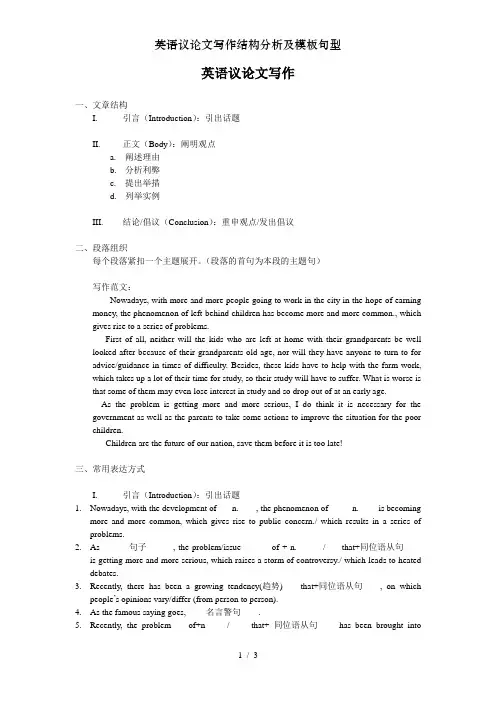
英语议论文写作一、文章结构I.引言(Introduction):引出话题II.正文(Body):阐明观点a.阐述理由b.分析利弊c.提出举措d.列举实例III.结论/倡议(Conclusion):重申观点/发出倡议二、段落组织每个段落紧扣一个主题展开。
(段落的首句为本段的主题句)写作范文:Nowadays, with more and more people going to work in the city in the hope of earning money, the phenomenon of left-behind children has become more and more common., which gives rise to a series of problems.First of all, neither will the kids who are left at home with their grandparents be well looked after because of their grandparents old age, nor will they have anyone to turn to for advice/guidance in times of difficulty. Besides, these kids have to help with the farm work, which takes up a lot of their time for study, so their study will have to suffer. What is worse is that some of them may even lose interest in study and so drop out of at an early age.As the problem is getting more and more serious, I do think it is necessary for the government as well as the parents to take some actions to improve the situation for the poor children.Children are the future of our nation, save them before it is too late!三、常用表达方式I.引言(Introduction):引出话题1.Nowadays, with the development of ___n.____, the phenomenon of _____n.____ is becomingmore and more common, which gives rise to public concern./ which results in a series of problems.2.As ______句子______, the problem/issue _____of + n.______/ ___that+同位语从句____is getting more and more serious, which raises a storm of controversy./ which leads to heated debates.3.Recently, there has been a growing tendency(趋势) ___that+同位语从句____, on whichpeople’s opinions vary/differ (from person to person).4.As the famous saying goes, ____名言警句____.5.Recently, the problem ___of+n____ / ____that+ 同位语从句____ has been brought intofocus/attention.6.There has been a public debate on/over the issue ____of +n____ these days.7.Nowadays, it is commonly /generally/ widely /increasingly held /believed /accepted/acknowledged that _______观点_______。
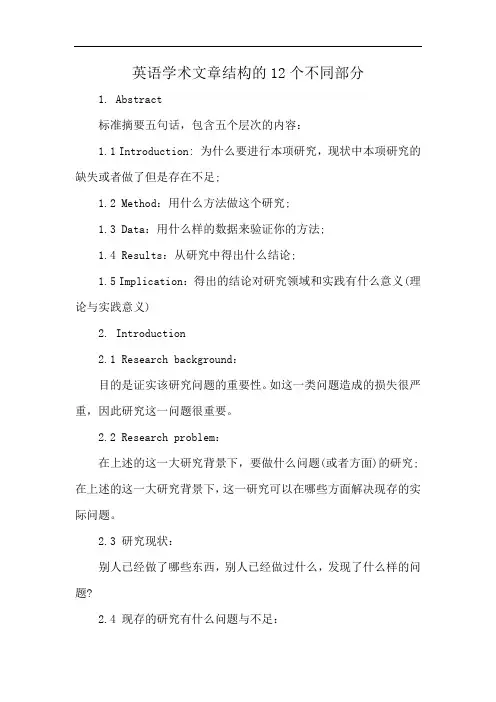
英语学术文章结构的12个不同部分1. Abstract标准摘要五句话,包含五个层次的内容:1.1 Introduction: 为什么要进行本项研究,现状中本项研究的缺失或者做了但是存在不足;1.2 Method:用什么方法做这个研究;1.3 Data:用什么样的数据来验证你的方法;1.4 Results:从研究中得出什么结论;1.5 Implication:得出的结论对研究领域和实践有什么意义(理论与实践意义)2. Introduction2.1 Research background:目的是证实该研究问题的重要性。
如这一类问题造成的损失很严重,因此研究这一问题很重要。
2.2 Research problem:在上述的这一大研究背景下,要做什么问题(或者方面)的研究;在上述的这一大研究背景下,这一研究可以在哪些方面解决现存的实际问题。
2.3 研究现状:别人已经做了哪些东西,别人已经做过什么,发现了什么样的问题?2.4 现存的研究有什么问题与不足:别人有什么没有做过?为什么别人没有做得更好?并说明这些研究不足会带来严重后果。
2.5 本研究的目标(objective)和研究范围(scope):本研究弥补这些问题中(这些没做过或者做过没做好的问题中)的哪些不足,采用什么研究方法去弥补不足。
陈述本项研究的范围局限,并高度概括本论文研究结论。
2.6 文章结构:本论文的后续部分的基本内容架构。
3. Literature review目的:Literature review证明与说明两件事情:一是研究目标的设定是有意义的;二是你在本研究中采用的方法是可靠的、有效的。
包括三个层次的内容:3.1 对选题(你找到的研究问题)的justification。
即对做过没做好或者没做过的研究问题,在这个研究领域,针对research problem而言,让读者明白本项研究是有意义的;3.2 现存文献中对本文值得参考并可借鉴的东西(包括分析工具和成果);3.3 非相关或者相邻研究领域值得借鉴的东西,侧重于可借鉴的研究方法。
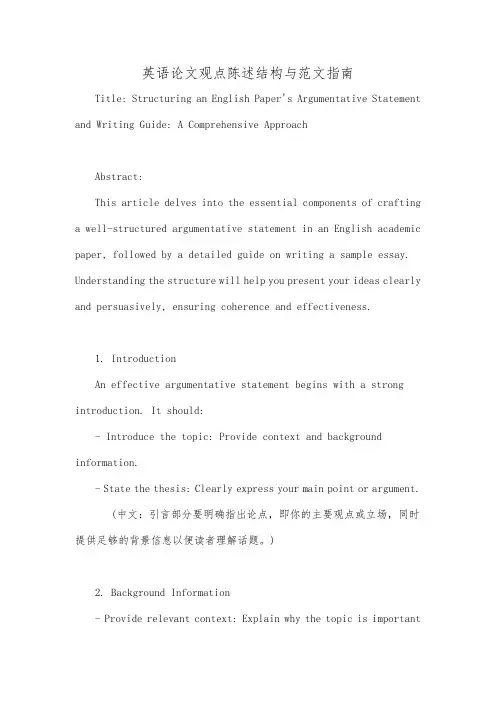
英语论文观点陈述结构与范文指南Title: Structuring an English Paper's Argumentative Statement and Writing Guide: A Comprehensive ApproachAbstract:This article delves into the essential components of crafting a well-structured argumentative statement in an English academic paper, followed by a detailed guide on writing a sample essay. Understanding the structure will help you present your ideas clearly and persuasively, ensuring coherence and effectiveness.1. IntroductionAn effective argumentative statement begins with a strong introduction. It should:- Introduce the topic: Provide context and background information.- State the thesis: Clearly express your main point or argument.(中文:引言部分要明确指出论点,即你的主要观点或立场,同时提供足够的背景信息以便读者理解话题。
)2. Background Information- Provide relevant context: Explain why the topic is importantor timely.- Establish your stance: Justify your position and its significance.(中文:介绍相关背景信息,说明为什么这个话题重要且具有现实意义,以及你的立场为何值得讨论。
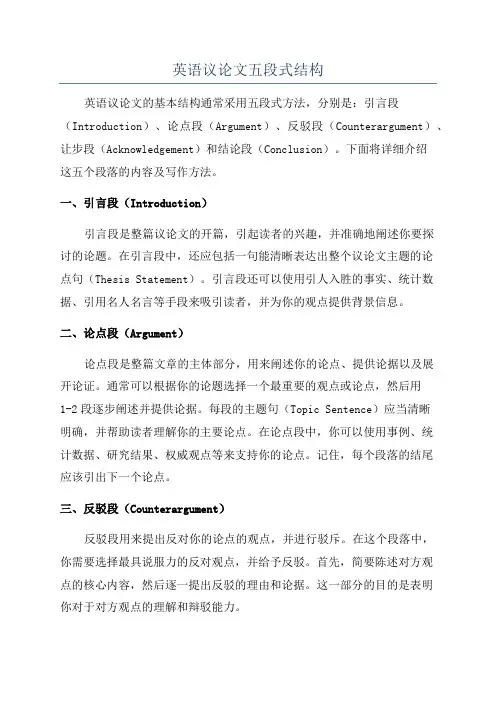
英语议论文五段式结构英语议论文的基本结构通常采用五段式方法,分别是:引言段(Introduction)、论点段(Argument)、反驳段(Counterargument)、让步段(Acknowledgement)和结论段(Conclusion)。
下面将详细介绍这五个段落的内容及写作方法。
一、引言段(Introduction)引言段是整篇议论文的开篇,引起读者的兴趣,并准确地阐述你要探讨的论题。
在引言段中,还应包括一句能清晰表达出整个议论文主题的论点句(Thesis Statement)。
引言段还可以使用引人入胜的事实、统计数据、引用名人名言等手段来吸引读者,并为你的观点提供背景信息。
二、论点段(Argument)论点段是整篇文章的主体部分,用来阐述你的论点、提供论据以及展开论证。
通常可以根据你的论题选择一个最重要的观点或论点,然后用1-2段逐步阐述并提供论据。
每段的主题句(Topic Sentence)应当清晰明确,并帮助读者理解你的主要论点。
在论点段中,你可以使用事例、统计数据、研究结果、权威观点等来支持你的论点。
记住,每个段落的结尾应该引出下一个论点。
三、反驳段(Counterargument)反驳段用来提出反对你的论点的观点,并进行驳斥。
在这个段落中,你需要选择最具说服力的反对观点,并给予反驳。
首先,简要陈述对方观点的核心内容,然后逐一提出反驳的理由和论据。
这一部分的目的是表明你对于对方观点的理解和辩驳能力。
四、让步段(Acknowledgement)让步段用来表明你主张的论点并不是绝对正确,存在一定的局限性。
在这个段落中,你可以通过承认一些相对的真实性或合理性来增加你论点的可信度。
与此同时,你仍然要强调自己的观点正确性的主要方面。
这部分的目的是表明你能够考虑到问题的多方面角度,并加强你的论证力度。
五、结论段(Conclusion)结论段是整篇文章的总结和结束。
在结论段中,你需要重新强调你的主要观点和论点,并总结你的关键论证。
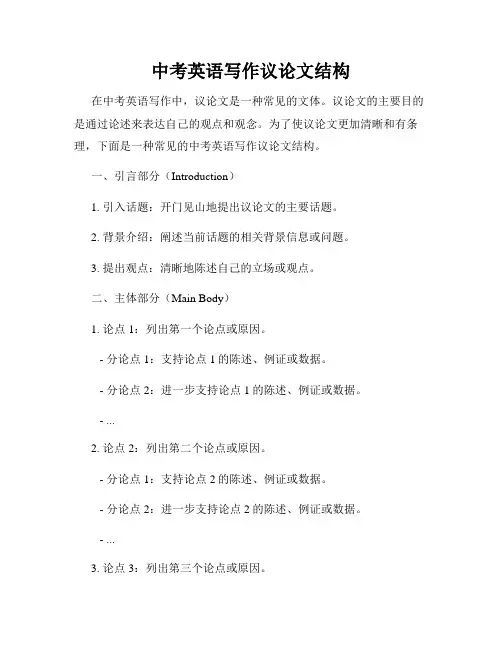
中考英语写作议论文结构在中考英语写作中,议论文是一种常见的文体。
议论文的主要目的是通过论述来表达自己的观点和观念。
为了使议论文更加清晰和有条理,下面是一种常见的中考英语写作议论文结构。
一、引言部分(Introduction)1. 引入话题:开门见山地提出议论文的主要话题。
2. 背景介绍:阐述当前话题的相关背景信息或问题。
3. 提出观点:清晰地陈述自己的立场或观点。
二、主体部分(Main Body)1. 论点1:列出第一个论点或原因。
- 分论点1:支持论点1的陈述、例证或数据。
- 分论点2:进一步支持论点1的陈述、例证或数据。
- ...2. 论点2:列出第二个论点或原因。
- 分论点1:支持论点2的陈述、例证或数据。
- 分论点2:进一步支持论点2的陈述、例证或数据。
- ...3. 论点3:列出第三个论点或原因。
- 分论点1:支持论点3的陈述、例证或数据。
- 分论点2:进一步支持论点3的陈述、例证或数据。
- ...三、对立观点部分(Opposing Viewpoints)1. 引出对立观点:简要介绍与自己观点相对立的观点或论据。
2. 反驳对立观点:用事实、数据或逻辑推理来反驳对立观点,展示自己的观点更为合理。
四、结论部分(Conclusion)1. 总结观点:简要总结前文的观点和论据。
2. 强调立场:再次明确和强调自己的立场。
3. 结束语:用简洁而有力的语言结束议论,给读者留下深刻印象。
需要注意的是,在写作议论文时,要保持逻辑严密、观点明确,同时运用恰当的论证手法,如比较对照、举例说明、引用专家观点等,以加强论证的说服力。
同时,合理使用恰当的连接词和过渡词语,使文章的结构更加清晰流畅。
以上是一种常见的中考英语写作议论文结构,希望能对你有所帮助。
在实际写作时,根据具体的题目和要求,可以灵活调整和适当增加内容来完善文章。
记得在写作中注重语法和拼写的准确性,以确保整篇文章的质量。
祝你在中考英语写作中取得好成绩!。

学术英语写作的结构
学术英语写作的结构通常遵循一定的模式,以下是一种常见的结构:1.引言(Introduction):在引言部分,作者简要介绍论文的主题、
研究背景、研究目的和研究问题。
此外,还可以提供一些相关的文献综述,以帮助读者更好地理解论文的背景和重要性。
2.文献综述(Literature Review):文献综述部分对已有的相关研究
进行总结和分析,为论文的研究问题提供理论支持和背景信息。
这一部分应该包括对相关研究的批判性评价,以及当前研究的空白和需要进一步探讨的问题。
3.研究方法(Research Methodology):在研究方法部分,作者详细
介绍研究设计、数据采集和分析方法、样本和抽样方法等。
这一部分应该清楚地说明研究是如何实施的,以及如何收集和分析数据的。
4.结果与讨论(Results and Discussion):结果与讨论部分呈现研究
结果,并对结果进行解释和讨论。
这一部分应该包括对数据的描述性分析、推断性分析和解释性分析,以及对结果的讨论和意义。
5.结论(Conclusion):结论部分总结论文的主要发现和贡献,并对
未来研究提出建议。
这一部分应该强调研究的局限性、对理论和实践的贡献,以及对未来研究的启示。
6.参考文献(References):参考文献部分列出文中引用的各篇文献,
按照规定的格式编排,如APA、MLA等。
这一部分应该包括所有引用的文献,以便读者查阅和核实。
以上是一种常见的学术英语写作结构,但具体的结构安排可能因学科领域、论文类型和个人偏好而有所不同。
在写作时,作者应该根据论文的具体要求和规范进行适当的调整。
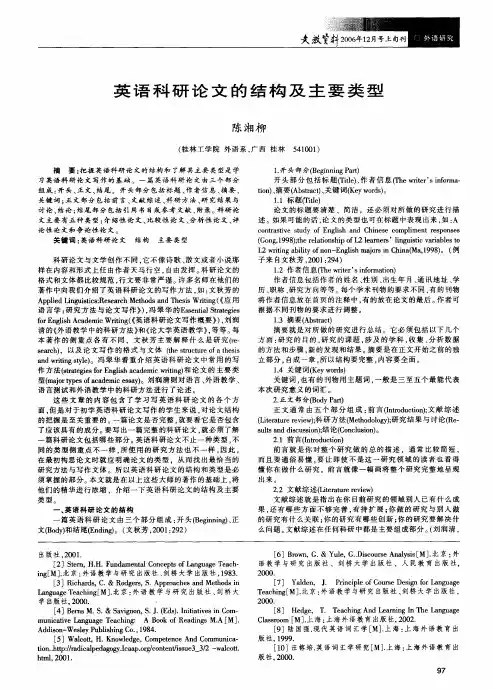
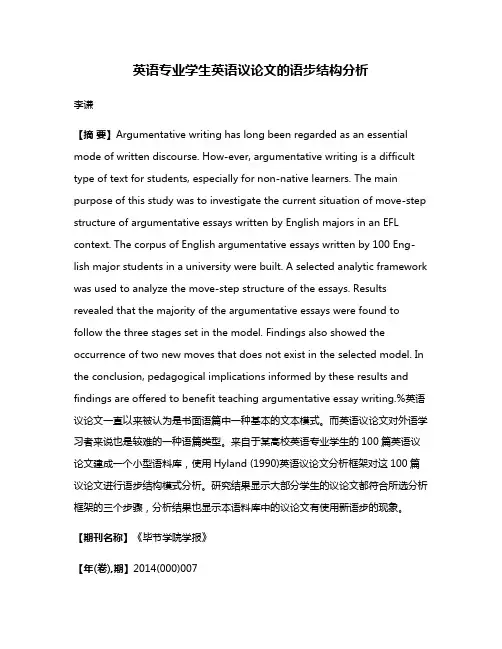
英语专业学生英语议论文的语步结构分析李谦【摘要】Argumentative writing has long been regarded as an essential mode of written discourse. How-ever, argumentative writing is a difficult type of text for students, especially for non-native learners. The main purpose of this study was to investigate the current situation of move-step structure of argumentative essays written by English majors in an EFL context. The corpus of English argumentative essays written by 100 Eng-lish major students in a university were built. A selected analytic framework was used to analyze the move-step structure of the essays. Results revealed that the majority of the argumentative essays were found to follow the three stages set in the model. Findings also showed the occurrence of two new moves that does not exist in the selected model. In the conclusion, pedagogical implications informed by these results and findings are offered to benefit teaching argumentative essay writing.%英语议论文一直以来被认为是书面语篇中一种基本的文本模式。
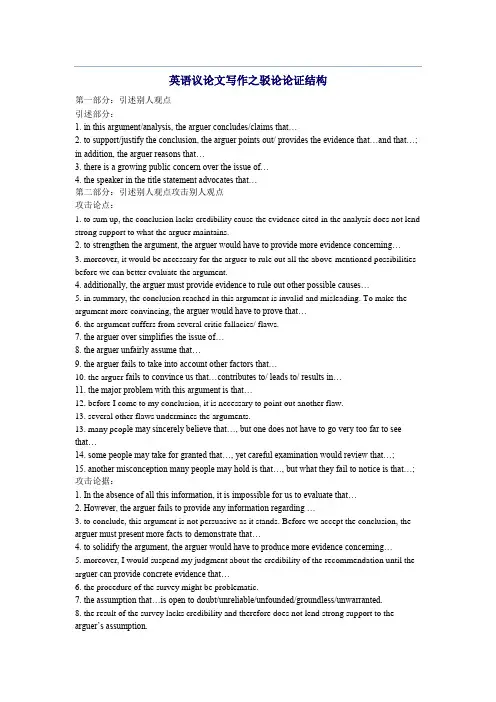
英语议论文写作之驳论论证结构第一部分:引述别人观点引述部分:1. in this argument/analysis, the arguer concludes/claims that…2. to support/justify the conclusion, the arguer points out/ provides the evidence that…and that…; in addition, the arguer reasons that…3. there is a growing public concern over the issue of…4. the speaker in the title statement advocates that…第二部分:引述别人观点攻击别人观点攻击论点:1. to sum up, the conclusion lacks credibility cause the evidence cited in the analysis does not lend strong support to what the arguer maintains.2. to strengthen the argument, the arguer would have to provide more evidence concerning…3. moreover, it would be necessary for the arguer to rule out all the above-mentioned possibilities before we can better evaluate the argument.4. additionally, the arguer must provide evidence to rule out other possible causes…5. in summary, the conclusion reached in this argument is invalid and misleading. To make the argument more convincing, the arguer would have to prove that…6. the argument suffers from several critic fallacies/ flaws.7. the arguer over simplifies the issue of…8. the arguer unfairly assume that…9. the arguer fails to take into account other factors that…10. the arguer fails to convince us that…contributes to/ leads to/ results in…11. the major problem with this argument is that…12. before I come to my conclusion, it is necessary to point out another flaw.13. several other flaws undermines the arguments.13. many peop le may sincerely believe that…, but one does not have to go very too far to see that…14. some people may take for granted that…, yet careful examination would review that…;15. another misconception many people may hold is that…, but what they fail to notice is that…;攻击论据:1. In the absence of all this information, it is impossible for us to evaluate that…2. However, the arguer fails to provide any information regarding …3. to conclude, this argument is not persuasive as it stands. Before we accept the conclusion, the arguer must present more facts to demonstrate that…4. to solidify the argument, the arguer would have to produce more evidence concerning…5. moreover, I would suspend my judgment about the credibility of the recommendation until the arg uer can provide concrete evidence that…6. the procedure of the survey might be problematic.7. the assumption that…is open to doubt/unreliable/unfounded/groundless/unwarranted.8. the result of the survey lacks credibility and therefore does not lend strong support to the arguer’s assumption.9. the comparison between A and B is incomplete.攻击论证逻辑:1. As it stands, the argument is not well reasoned. To make it logically acceptable, the arguer would have to demonstrate that…2. the arguer commits a fallacy of…3. the arguer fails to establish a causal relationship between A and B.4. another problem that weakens/undermines the logic of this argument is that…第三部分:引述别人观点攻击别人观点表述自己的观点表达观点:1. according t the title statement,…, while I agree that…;2. I insist that…;3. it is natural that…;4. it is natural that people may disagree each other over such a controversial issue due to their different experience and values. On balance, I am inclined to support/ oppose the idea that…5. in the last analysis, I argue that…;6. in my opinion, …;第四部分:引述别人观点攻击别人观点表述自己的观点展开具体论证论证:1. in the first place, in the second place,…, last;2. firstly, secondly,…, lastly;3. to begin with, next, in addition, finally;4. to start with, moreover, additionally, last;5. first of all/ first and foremost, moreover, additionally, last but not least, finally;6. on the one hand,…, on the other hand,…;7. for one thing, for another thing;。
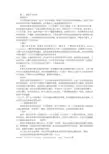
篇一:英语作文结构一、段落写作写作的过程包括选词、造句、组段和成篇。
四级作文的写作也同样遵循这一规律。
但四级考试的写作囿于篇幅的限制,从严格意义上说是凝练的段落写作。
段落是由彼此关联的表达相对单一中心思想的一组句子构成,它是一篇文章或书中某一章节的基本构成部分,也是文章结构的基本独立部分。
段落由若干个句子组成,通常表达一个中心思想。
因此,段落不能由一组句子随意堆砌而成,而是应当符合一定的模式和具有某些基本特征,并遵循一定的段落发展方法。
大学英语的写作重点就要从选词造句转到联句成段和联段成篇上。
进行段落层次上的写作训练,是写好文章的关键所在。
段落由主题句、扩展句和结尾句三部分构成。
主题句主题句是介绍某一段落主要内容的句子,通常是一个概括性的陈述(a general statement)。
主题句把纷繁的现象通过简练的文字用一句话扼要地指出这一段落的中心内容。
主题句在开头是最常用的做法,这样读者和作者都非常容易进入段落的主题。
写作时不断地对照主题句,可以让作者避免把不相关的内容写入这一段落;主题句放的中间,多出现于作者对两件事情作比较时,说明两者如何相象,又如何不同;主题句出现在段落的末尾,往往是作者为创造一种悬念而有意安排的,目的是让读者继续读下去,可以在读者心目中留下一个深刻的印象。
扩展句扩展句是段落主题句的延伸和发展,起着辅助主题句和拓展段落中心的作用。
它对主题句的中心思想或者举例说明,或者详细解释和论证。
扩展句一般由几个或十几个意思连贯的句子组成。
扩展句应具有清晰翔实、条理分明的特点。
结尾句结尾句就是总结段落的句子,它在段落中起着非常重要的作用,它用一句话将段落内容进行归纳总结,对全段中心思想作出精炼的浓缩。
因为段落的内容是说明主题的,因此结尾句常和段落主题句呼应,或者说是主题句的再现,并与扩展句相关联。
结尾句可以用不同的方法再现主题,有时甚至就是段落的主题句。
但有时在一段文章中,尤其是较短的段落中,只有主题句,而没有结尾句;而当主题句位于段尾时,主题句就是结尾句。
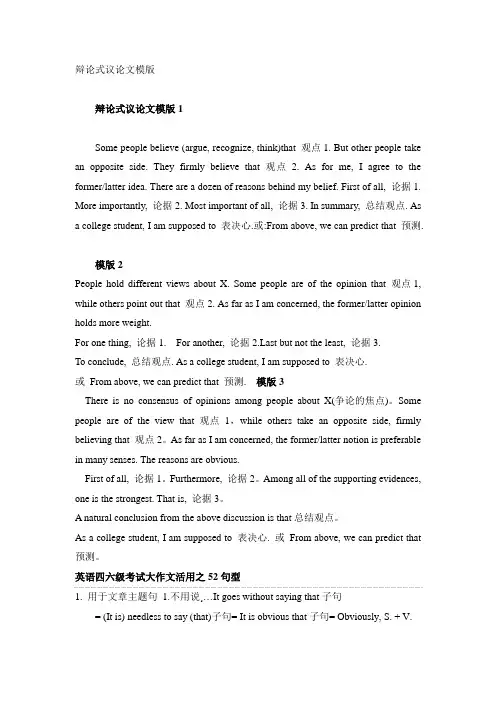
辩论式议论文模版辩论式议论文模版1Some people believe (argue, recognize, think)that 观点1. But other people take an opposite side. They firmly believe that 观点 2. As for me, I agree to the former/latter idea. There are a dozen of reasons behind my belief. First of all, 论据1. More importantly, 论据2. Most important of all, 论据3. In summary, 总结观点. As a college student, I am supposed to 表决心.或:From above, we can predict that 预测.模版2People hold different views about X. Some people are of the opinion that 观点1, while others point out that 观点2. As far as I am concerned, the former/latter opinion holds more weight.For one thing, 论据1.For another, 论据st but not the least, 论据3.To conclude, 总结观点. As a college student, I am supposed to 表决心.或From above, we can predict that 预测.模版3There is no consensus of opinions among people about X(争论的焦点)。
英文论文难,不是难在写作素材上,而是难在不熟悉专业的词汇,中国的留学生大多本身的英语基础不好,很多都是应付各种考试而准备的词汇,和英语母语的外国学生相比,中国学生写作能力则欠缺不少。
还有一点,用英语写论文难,是因为不太了解学术英语的语言特点。
本文主要在于讨论学术论文写作的方法,包括学术论文写作中常用的句型结构,对于很多初次写作的新手来说应该有所帮助,大家可以模仿和学习,以便自己的英文论文化难为易。
下面我们来看看英文论文的写作技巧有哪些?一般来说,一篇完整规范的学术论文由以下各部分构成:Title(标题)Abstract(摘要)Keywords(关键词)Table of contents(目录) Nomenclature(术语表)Introduction(引言)Method(方法)Results(结果)Discussion(讨论)Conclusion(结论)Acknowledgement(致谢)Reference(参考文献)Appendix(附录)其中 Title,Abstract,Introduction,Method,Result,Discussion,Conclusion,Reference 等八项内容是必不可少的(其他内容根据具体需要而定)。
在这八项内容中,读者最多的是Title,Abstract和Introduction部分,读者会根据这些内容来决定是否阅读全文。
也就是说,一篇研究论文赢得读者的多少,在很大程度上取决于Title,Abstract和Introduction 写得好坏。
因此这三项内容将各分章详细加以讲述。
学术论文的正文一般包括Method,Result,Discussion三个部分。
这三部分主要描述研究课题的具体内容、方法,研究过程中所使用的设备、仪器、条件,并如实公布有关数据和研究结果等。
Conclusion是对全文内容或有关研究课题进行的总体性讨论。
它具有严密的科学性和客观性,反映一个研究课题的价值,同时提出以后的研究方向。
如何写高中英语议论文高中英语作文中最重要的两点,一是结构,二是逻辑。
英语作文的结构是很严谨的,每个段落必然有每个段落的中心意思;从逻辑层面讲每一句话都有它的目的性和功能,绝没有一句废话。
这两个要求不仅是英语写作思维的体现,也是高中英语应试的技巧之一。
高中英语作文从结构上讲一般分为三段,也就是总分总,还可以写四段,总分分总,写五段——总分分分总也是可以的,但是基本很少见(因为想出三个论据在考场上并不容易,且时间有限)。
如果以三段式写一篇议论文,那么首先请先记住这三段的分工——第一段:综述、摆立场、亮论点;第二段:分别细说你的原因/论据;第三段:总结。
也就是说,第一段应该总述如今的情况,即大家怎么样意见不一,分为了怎么样的两种对立阵营。
然后提出你的意见,你站哪边,你支持什么样的观点,因为:1和2。
或你的原因有两点,分别是1和2。
既然说到了1和2,那么在接下来的第二段里你就必须阐述这两种原因。
首先,……(原因1);其次,……(原因2)。
有些同学写四段的原因就是把原因1和原因2分成了两段写。
最后开始第三段,也就是总结段,再次回到你的论点,因为原因1和原因2,所以我认为……(论点/立场)。
举个例子,假如题目中说目前关于游客该不该进入校园的讨论很火,有些人认为应该允许游客进校园,有些人则反对,你的意见是?假设你的意见不同意,下面为参考的例文框架:Tourists shouldn’t be Allowed to Enter the Campus 如今,对于游客该不该进校园的讨论很火爆。
有些人认为游客可以进入校园,有些人认为不可以。
(综述)我认为,游客不可以进入校园,(摆立场)因为他们不仅打扰学生学习,而且对校园环境造成影响。
(亮论点)首先,游客们影响学生学习。
(论据1)有很多游客进入校园后不按规定的休息时间游玩,而是随意走动,甚至在教室边徘徊,这给校园造成了很多噪音,极大地影响了学生的学习。
(论据1阐述)其次,游客们影响校园环境。
高中英语知识点归纳写作议论文的结构在高中英语学习中,写作议论文是一项重要的任务。
掌握写作议论文的结构和知识点,可以帮助我们更好地表达自己的观点并增强说服力。
本文将对高中英语写作议论文的结构和知识点进行归纳总结。
一、引言部分(Introduction)引言部分是议论文的开头,旨在引起读者的兴趣并明确文章的主题。
以下是引言部分的几个要素:1.引入背景:阐明文章的背景信息,概括性地介绍讨论的主题。
2.引出问题:提出争议或问题,明确陈述主题的重要性和相关性。
3.陈述立场:明确阐述自己的观点并简要概括主要论点。
二、论点部分(Body)论点部分是议论文的核心部分,主要论述自己的观点并提供支持或证据。
以下是论点部分的几个要素:1.主题句:在每个段落的开头,明确指出该段的主要论点。
2.论据和证据:提供支持观点的事实、数据、例证等,使读者能够理解和接受自己的观点。
3.分析和解释:对于提供的证据进行分析和解释,说明其与观点的关系和重要性。
三、反驳部分(Counterargument)反驳部分是辩证性写作的重要组成部分,可以增强文章的说服力。
以下是反驳部分的几个要素:1.反驳观点:列举反对自己观点的理由或证据。
2.承认优点:承认反对观点的一些合理性和优点。
3.驳斥反驳:通过提供更有说服力的证据或观点,驳斥反对观点。
四、结论部分(Conclusion)结论部分是议论文的结尾,旨在总结文章的重点观点并回答问题。
以下是结论部分的几个要素:1.总结观点:简要回顾并概括文章中主要的观点和论据。
2.强调重要性:强调自己的观点的重要性和合理性。
3.提出建议或展望:针对讨论的问题,提出建议或展望未来可能的发展。
五、语言技巧和注意事项1.使用恰当的过渡词语,使文章内容连接紧密,逻辑清晰。
2.使用恰当的引用和引号,标明其他人的观点或权威性证据。
3.避免使用个人化的语言,要客观、中立地陈述观点。
4.注意语法和拼写错误,以确保文章语句通顺、流畅。
英语议论文结构
英语的议论文可以采用以下结构:
1. 引言部分:
a. 引入主题:引出讨论的问题或观点。
b. 陈述论点:明确自己的立场或主张。
2. 论证部分:
a. 提供证据或例子:用事实、数据或具体案例来支持自己的观点。
b. 分析和解释:呈现证据和例子的意义,解释它们与论点之间的关系。
3. 反驳部分:
a. 对反对观点进行强化:列举可能的反对观点,并提供论证来反驳它们。
b. 解释为什么反对观点不正确或有缺陷:分析反对观点的问题和逻辑上的错误。
4. 结论部分:
a. 确认自己的立场:重申自己的主张。
b. 总结主要观点:回顾主要论点和证据。
c. 提出建议或呼吁:根据主题和立场,提出解决问题或行动的建议。
5. 结束部分:
a. 总结思想:通过总结表明自己的结论。
b. 提出倡议或呼吁:鼓励读者采取特定的行动或思考。
这种结构能够清晰地组织论点,使读者更容易理解和跟随。
同时,适当的过渡句和连接词也非常重要,以确保论文的连贯性和流畅性。
题目A Contrastive Study between English and Chinese Idioms(题目:二号,黑体,加粗,居中,除了英语小词外,其他单词首字母都要大写;另外:除了题目外,论文中所有英文的字体均采用“Times New Roman”)(学院、专业、学号、作者姓名、指导教师姓名(小四号宋体字,加粗),依次排印在论文题目下,上空二行,居中)AbstractThis paper centers on the different expressions of …… (英文摘要:上空二行;题目采用五号“Times NewRoman”字体,加粗,置于粗体方括号【】内,顶格放置;随后的内容与前面的粗体方括号【】之间空一格,不用其他任何标点符号;采用五号“TimesNew Roman”字体,不加粗;单倍行距。
)Key Wordidiom; comparison; English; Chinese(英文关键词:题目采用五号“Times NewRoman”字体,加粗,两个单词的首字母要大写,置于粗体方括号【】内,顶格放置;随后的内容与前面的粗体方括号【】之间空一格,不用任何其他标点符号,采用五号“Times New Roman”字体,不加粗,除了专有名词外,其他单词的首字母不大写,各单词之间用分号“;”隔开,分号之后空一格;最后一个关键词之后不用任何标点符号;单倍行距。
)Introduction(顶格,除了第一个单词及专有名词外,其他单词首字母都不要大写;标题最后不用任何标点符号,上空两行)In both English and Chinese, …. So, this essay is trying to focus on the differences between Chinese and English idoms in termsof their essential meaning, customary usage and typical expression(Chang Liang, 1993:44; Li Guangling, 1999).(段落第一行缩进4个英文字符;夹注的标注法:出现在夹注中的作者必须与文后的参考文献形成一一对应关系;注意一个或多个作者间的标点符号,时间、页码等的标注法;另外,汉语参考文献的作者要以拼音形式出现,不能出现汉语姓氏;夹注出现在标点符号之前)正文. The similarities between English idioms and Chinese idioms In English, …. And it can be clearly seen in the below exam ples:(1) I don’t know。